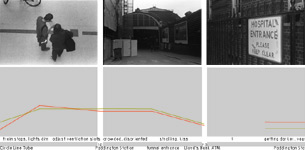| |
| |
| |
TECHNOLOGICAL AND SOCIAL STRATEGY
Based on existing technology for collecting location-based
data and express political strategy in London, Local
Beat was fictionally situated in myneighborhood.
In the proposed system, participants would wear
an EMT patch which transmits readings of their stress
level to local receivers, which is sent to GPS satellites,
collected in online datasets, downloaded into customized
visualization software, and projected onto a map
located in the local subway station.
The real-time public map gives locals an overview
of hotspots, incidents, and danger zones. Effectively
displaying the collective stress level of the neighborhood,
muggings, bomb scares, and traffic jams are reported
visually by the emotional impact they have on the
people involved. The project explored not only the
system design but presented scenarios of the system
in use, including the emotional importance of the
map and its role in everyday rituals, as well as
suggesting potential for misuse of the public system.
DESIGN METHODS
The starting point for the project brief was exploration
of an extreme psychological condition. Taking Post-Traumatic
Stress Disorder (a widespread condition in urban
areas traumatized by natural and socio-political
disorders), my design methods involved immersion
into both the emotional and physical conditions
of the local context. Design methods included logging
observations of locals, role-playing potential situations,
and creating value scenarios of potential users.
The methodology was intended to open a new dimension
within real, familiar sites, a dimension of psychological
and emotional experience.
At the same time, with this approach, it became
clear that the role of the designer is implicitly
political, implementing products which change behaviour,
public opinion, and social practices. The aim of
the project became not only to design a system but
to expose such designed values. In this way, the
project extended beyond the usual scope of architectural
or design practice. Related to approaches in critical
design discourse, Local Beat allowed exploration
of things which architecture doesn’t usually
consider – like public behavior and psychological
experience – and things which design doesn’t
necessarily consider – such as the ‘future
life ’ of a product and the space for appropriation.
OUTCOME
• a system design for an affective neighborhood
watch scheme
• a ‘value fiction’ about the product
as if it was implemented |
|
|
 |
| |
DETAILS
Project
report 1MB PDF
06.1999, 4 week project
"Placebo" project brief
Tutors: Anthony Dunne & Fiona Raby
Royal College of Art
|
| |
|